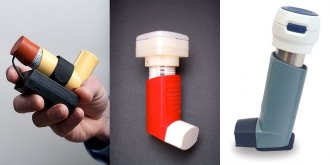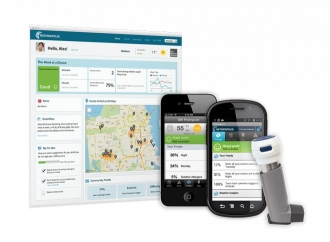Asthma sucks. It’s a chronic disease that can constrict your breathing to the point of killing you. There’s medication to help you manage it, but getting the dosage and regime right means your doctor needs detailed information about your experience with the disease. The problem there is that people are terrible at accurately recording this information. David Van Sickle, founder and CEO of Asthmapolis, thinks we can do better.
Asthmapolis is a suite of tools designed to help patients and health providers better monitor the behavior of asthma. At the heart of the system is a Bluetooth-enabled sensor that you attach to your inhaler. Every time you use it, the sensor records the time and your location. Using a smartphone or base station, that information is in turn transferred to Asthmapolis’ servers where the data can be used by individuals to track their response to treatments or by public health officials to spot and map patterns and outbreaks.
Van Sickle says the project grew out of his work at the CDC, investigating outbreaks of respiratory illness, and then again working in clinical practice. “There’s a ton of variability of asthma within micro-environments,” he says. This means that it’s crucial to get precise information about where and how often they need their puffer. This data is very hard to collect.
“Historically in asthma we haven’t done much except provide patients with a rationale for keeping pen and paper and encouraging them to bring them to their next visit,” says Van Sickle. The problem is that no one likes doing this; it’s just one more burden that comes with the disease. So people forget, or procrastinate, or try to guess. “We know those diaries are often inaccurate,” he says, “They’re generally fabricated.”

Asthmapolis aims to solve this by making data collection part of the act of taking the medicine. The sensor is installed on the top of the puffer that patients use to relieve symptoms. When you press down, the sensor detects that you’ve used the medicine, and the GPS and clock record where and when.
To do this has required a series of refinements, each one aiming to make the attachment as unobtrusive as possible. The physical sensor has gone through three major versions. To design the most recent one, Asthmapolis worked with designers at Synapse Product Development. This needs to be unobtrusive, and the fact that it’s attached to a life-saving device brings with it a lot of constraints.
It needs to work for people with a variety of sizes and strengths of hands; it can’t make the medicine any more difficult to administer; the medicine comes in disposable containers, so it needs to be transferable; it can’t make carrying the medicine more inconvenient; it can’t in any way impact how much is delivered. On top of that, the things needs to be waterproof and rugged. People take their puffers with them everywhere and as a result, the sensors “have an active daily life.”
“Asthma patients are a tough demographic,” says Van Sickle, “We’ve got kids, older folks, people where it’s work related, people who need it when they exercise, and people who don’t use it often.”
As important as it is, the sensor itself is just the physical tip of a service iceberg. The collected data is relayed to Asthmapolis’ servers. From there, patients and physicians can look at personalized information about where and when they find themselves having an attack. In turn, Asthmapolis can aggregate the data together and begin to piece together larger patterns.
Because the data collection is automated, providers can get an accurate picture of when their patients are having trouble managing the disease and — more interestingly, when they aren’t. “One benefit that sensor-driven products have is that you know when somebody has used the inhaler and you know when they haven’t,” says Van Sickle, “It makes the absence of data meaningful.”

“Data from the medications and how often people use them is the most important marker,” says Van Sickle. With that data, health providers can begin to get accurate pictures of their patients’ progress as well as real-time warnings of asthma hotspots, that could herald some new trigger in the environment.
“Our company succeeds to the extend that we make it easier for patients to manage asthma,” says Van Sickle. So it was important that the design of the sensor be as unobtrusive as possible. “We wanted it to be like a machine that helps them accomplish work rather than adding to the day-to-day burden.”
Asthmapolis has done several field trials and has an ongoing beta program with testers across the U.S. Most notably, they’re running a project in Louisville, Kentucky, spearheaded by Mayor Greg Fischer and for which Kentucky won a grant from IBM’s Smarter Cities Challenge. Van Sickle says the company is also working hard to hammer out a deal for a Medicaid managed care contract.
The reality of asthma is that, while many people suffer from it, it’s disproportionately a poor person’s disease. Van Sickle says he’s proud that Asthmapolis is making inroads to places where it can help the most. “We didn’t want to build something that only people who are already doing well could benefit from.”
By Tim Maly, Wired Magazine